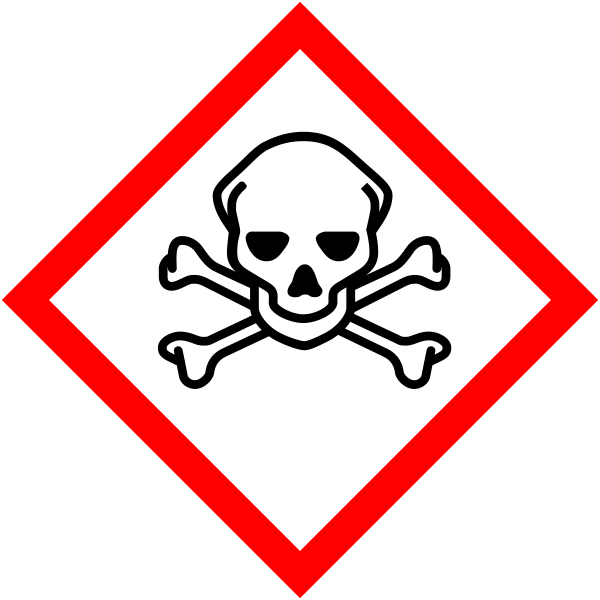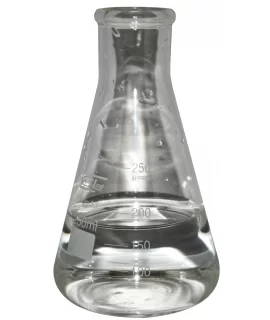NITRIC ACID (Tech grade), 55%, L
6.99 €
Nitric acid, CAS 7697-37-2, hydrogen nitrate, INCI NITRIC ACID, Aqua fortis, Spirit of niter, Eau forte, Hydrogen nitrate, Acidum nitricum.
Parameter | Attribute |
Nitric acid | Nitric acid, Hydrogen nitrate, Aqua fortis, Spirit of niter, Eau forte, Acidum nitricum |
Formula | HNO3 |
Structure |   |
IUPAC | Nitric acid |
INCI | NITRIC ACID |
CAS | 7697-37-2 |
Molar mass | 63,012 g/mol |
Density | 1,39g/cm3 (55%) |
Solubility | Miscible |
Nitric acid (HNO3), also known as aqua fortis (Latin for "strong water") and nitro alcohol, is a highly corrosive mineral acid. The pure compound is colorless, but older samples tend to turn yellow due to decomposition into nitrogen oxides. When the solution contains more than 86% HNO3, it is called fuming nitric acid. Depending on the amount of nitrogen dioxide present, fuming nitric acid is further characterised as red fuming nitric acid at concentrations above 86% or white fuming nitric acid at concentrations above 95%.
In agriculture, nitric acid is used in the form of nitrogenous fertilisers such as calcium nitrates, ammonium nitrates, etc. Nitric acid is also used as a pH adjuster in irrigation water and thus as a source of nitrogen. It is particularly suitable for watering plants that like acidic soil (rosehips, raspberries, strawberries, etc.). It can also be used during flowering as an additional source of nitrogen. Indicative values for neutralising 50 ppm alkalinity in 1 m3 of water 79.40mL/m3 or 107.20 g/m3. The water is enriched with 14.3 ppm N element.
In the wood industry, nitric acid is used to artificially age pine and maple wood by about 10%. The result is a grey-gold color, similar to very old wax- or oil-finished wood. It is recommended to carry out a test in a low visibility area before treating the wood.
In the metal industry, nitric acid can be used to convert metals into oxidised forms, for example copper metal to copper nitrate. It can also be used in combination with hydrochloric acid as aqua regia to dissolve precious metals such as gold (as in the case of perchloric acid). These salts can be used to purify gold and other metals above 99,9% purity by recrystallisation and selective precipitation processes. For etching of metals, a solution of nitric acid, water and alcohol called Nital is used to reveal the microstructure of the metal. ISO 14104 is one of the standards describing this well-known procedure. Nitric acid with hydrochloric acid is also used to clean glass prior to silver plating when silver mirrors or silvered glass surfaces of automotive parts are produced.
In the laboratories, dilute nitric acid (0,5-5,0%) is used as a matrix compound for the determination of trace metals in solutions by elemental analysis by ICP-MS, ICP-AES, GFAA and flame atomic absorption spectroscopy. Nitric acid can be used as a rapid test for the detection of alkaloids (e.g. LSD). It is widely used in calorimetric tests to determine the differences between heroin and morphine.
In electrical engineering, nitric acid is used as a chemical agent for organic semiconductors, for cleaning and etching of electrical circuit boards and tracks, and for the cleaning of untreated carbon nanotubes.
In the cleaning industry, aqueous mixtures of 5-30% nitric acid and 15-40% phosphoric acid, with additional components, are used in the cleaning of equipment in the food and dairy industries, mainly for the removal of precipitated calcium and magnesium compounds (either from the process or from the use of hard water in production and cleaning). Phosphoric acid helps to passivate iron alloys against corrosion by dilute nitric acid
In the explosives industry, nitric acid is used to produce explosives such as TNT, smokeless powder, nitroglycerine, hexogen, etc. Due to this use, nitric acid is considered a precursor for explosives and is a restricted substance.
Important: Add the item to your basket, fill in the recipient's details and confirm your order. Thank you!
To save your precious time, we will deliver your order to your address at a time convenient for You!
*- The pictures of the goods may not correspond to the actual appearance, color, assembly or shape of the goods and their packaging. The information in the product description is of a general nature and may not correspond to the information on the packaging of the product and may not be the exact use of the product. The information given on the stocks and prices of goods may, in certain cases, differ from the actual prices and stocks of goods
**- Implementing Regulation (EU) 2019/1148 of the European Parliament and of the Council of 20 June 2019 on trade in and use of explosive precursors, amending Regulation (EC) No 1907/2006 and repealing Regulation (EU) No 98/2013 (OJ L 186, 11.7.2019, p. 1). The product shall only be sold to Legal Persons, farmers or self-employed persons after a signed confirmation of the authorisation to purchase and of the legitimate use by completing a declaration form.
Signal word: Danger |
Hazard icons:
|
Danger phrases: H331 Toxic by inhalation. H314 Severely burns skin and damages eyes. H290 May corrode metals. |
Precautionary statements: P271 Use only outdoors or in a well-ventilated area. P280 Wear protective gloves/protective clothing/eye/face protection. P261 Try not to inhale dust/ fumes/ gases/ mists/ vapours/ aerosols. P301+P330+P331 CAUTION: Rinse mouth. DO NOT induce vomiting. P303+P361+P353 IN CASE OF CONTACT WITH SKIN (or hair): Immediately remove/remove all contaminated clothing. Wash skin with water/urine. P305+P351+P338 IN EYES: Wash gently with water for several minutes. Remove contact lenses, if present and if easy to do so. Continue to wash eyes. P304+P340 INTRODUCTION: Remove the victim to fresh air; he/she must be calm and in a position to breathe freely. P321 Special treatment: In case of contact with skin, wash with 0,5 % boric acid solution. P501 Empty contents/container into stainless steel/acid-resistant plastic leak-proof, labelled packaging/containers. |
Related products
(8 other products in the same category)












